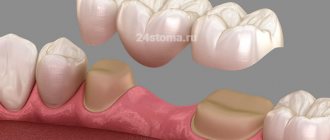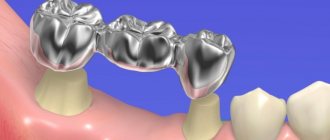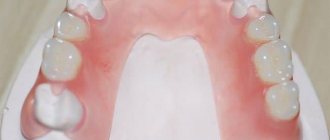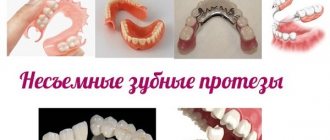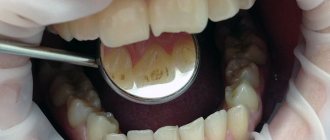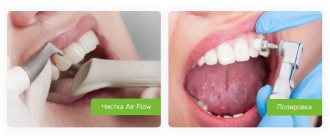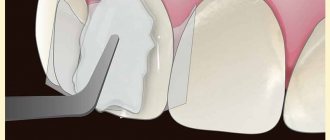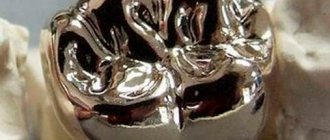At their core, crowns are dentures made in such a way that they are almost impossible to distinguish from real teeth. With the help of crowns, both one tooth and several nearby missing ones are restored.
The search for the optimal material for making dentures has led to the fact that dentists now offer a large number of them to choose from. But how can the average person navigate this diversity and choose the best dental crown? Specialists at the AcademyDENT clinic will try to answer this question. On our website you can see in the photo what a crown on a tooth made of different materials looks like.
When are dental crowns needed?
Dentists have identified the following indications for the installation of this type of prosthesis:
- Destruction of the crown part of the tooth by more than 50%. Most often, this situation occurs with severe caries or with injuries. In this case, a crown is installed to protect the tooth from further destruction.
- Protection of pulpless teeth. Removing a nerve from a dental canal is accompanied by a weakening of the enamel - it becomes fragile, so it is quite advisable to protect it with a crown.
- Any aesthetic defects: tetracycline teeth, fluorosis.
By contacting the AcademyDENT clinic, you are guaranteed to receive a qualified consultation with a doctor who will tell you exactly whether you need a dental crown or whether other treatment methods are possible.
Features of composite dental restoration.
Composite materials have been used in dentistry for over 50 years. And every year their quality improves, they become more reliable and durable. During the restoration process, the composite bonds to the surface of the tooth, strengthening and restoring its integrity. In some cases, when the crown is almost half destroyed, this restoration method is even preferable. It allows you to avoid depulpation (removal of the nerve) and the unit will not need to be ground down for an artificial insert.
Nowadays, almost all specialists have begun to use photo-curable materials in their work; with their help, you can achieve excellent aesthetic results. Of course, such structures as veneers, inlays and crowns greatly simplify the adjustment process; you just need to glue them on and your smile is already transformed. In the case of composite restoration, the dentist selects the appropriate shade of the material, carefully recreates parts of the damaged tooth, not forgetting about its features, tubercles and fissures. But even taking this fact into account, this aesthetic dentistry service has a number of advantages:
- The procedure is performed in one step.
- Reasonable price.
- Subject to the dentist's recommendations and proper care, the appearance of the restored teeth will remain for a long time.
- If the patient is not satisfied with the result, the restoration can be redone.
- Minimal grinding of healthy tooth tissue.
Contraindications
It is not possible to install a crown on every tooth - there are certain situations when the feasibility of its installation is highly questionable. Contraindications include:
- pathological tooth mobility;
- insufficient height of the tooth crown - in this case the prosthesis will sink;
- chronic inflammatory processes in the mouth;
- unfilled canals of the prosthetic tooth.
At AcademyDENT, doctors carefully follow all indications and contraindications for prosthetics, so we have an extremely low percentage of complications.
Methods of dental restoration.
In dentistry, there are two options for aesthetic restoration. The indirect method is used in more complex cases where it is necessary to restore severely damaged units and correct serious cosmetic defects. In this case, the whole process is extended over several appointments: first, the doctor conducts an examination and takes impressions, and then sends them to the laboratory where the restoration elements will be made. Another technique is direct restoration, which involves the use of composite materials. All manipulations are carried out directly in the patient’s mouth, in the dentist’s office. Sometimes the procedure can last several hours, which causes discomfort for the patient. In case of more significant chips and destruction of the unit, to strengthen it and to secure the filling well, a pin is installed in the root canal.
Stages of composite restoration.
Let's take a closer look at the stages of direct dental restoration.
- Preparatory.
To begin with, the dentist will conduct an examination, assess the condition of the teeth and gums, and, if necessary, prescribe oral sanitation. In order for the color of the restored area to be identical to the natural one, it is necessary to clean the teeth of plaque and stone. Only after this can a specialist correctly determine the appropriate shade of the composite.
- Cleansing.
For a painless procedure, the patient is given an injection with anesthetic drugs. After the anesthesia begins to take effect, carious tissue, remnants of old fillings and other contaminants that may cause poor contact between the photopolymer and the crown are removed from the surface of the tooth.
- Tooth shape modeling.
The filling material is applied in layers, the dentist combines different shades of the composite, creating a natural shade. At the same time, he tries to recreate the appearance of a natural tooth, taking into account its anatomical features. At the end of the procedure, the chewing surface of the unit is polished and ground so that nothing disturbs the patient.
Ceramic crown
Ceramics is the most suitable substance for making teeth, since in its composition and structure it is very close to tooth enamel. Ceramic crowns are an ideal option for prosthetic restoration of anterior teeth, as they provide the most effective aesthetic replacement.
So the advantages:
- excellent aesthetic effect;
- excellent prosthetics for both frontal and chewing teeth;
- resistant to dyes.
E-max glass-ceramic crown prostheses are becoming increasingly popular.
Metal crown
Dentures began to be made from metal almost 100 years ago. Initially, preference was given to gold - crowns were made from it quite simply, but were too soft. Gradually, a special gold-based alloy began to be used for crowns - the addition of other metals makes it possible to achieve high strength of the product.
Nowadays, dentists use not only precious metals (gold and silver) to make crowns, but also “base” metals: titanium and steel. All metal crowns have a rather low aesthetic quality - the presence of gold teeth in the mouth currently does not make a person beautiful. In addition, the cost of such products is actually not considered one of the lowest.
Metal-ceramic crown
In search of a compromise between the unaesthetic appearance of metal and the insufficient strength of ceramics, dentists developed metal-ceramic dental crowns. During their manufacture, a ceramic coating is applied to a metal base, masking the metal, while the metal base provides sufficient strength and rigidity. The advantages of such structures include:
- reasonable cost;
- natural appearance;
- strength comparable to conventional metal prostheses.
Disadvantage: when the gum recedes, the metal part of the crown appears from under it, which reduces its aesthetic value.
Dental restoration with composite materials.
Dentistry is actively developing every year; people’s eternal desire for everything beautiful has motivated specialists to create new, more advanced technologies for dental treatment and restoration. Over time, a new direction called aesthetic dentistry has emerged, which deals with these issues. It provides the opportunity to correct various cosmetic defects, and composite materials allow you to recreate the structure of the tooth, its anatomical shape and color. If filling only restores the functionality of the unit, then during its restoration the appearance is corrected. Let's talk in more detail about this unique technique.
Metal composite crowns
Another attempt to combine metals and non-metals in dental crowns is metal composite crowns. Their peculiarity lies in the manufacturing method - a light-curing composite is applied to a metal base. A new tooth is formed, similar to a real one. Such dental crowns are very attractive from an aesthetic point of view; they look very good both in place of the front teeth and in the place of chewing teeth.
But there are more disadvantages than advantages.
Composite crowns: average in price, but not in quality
So, you need to get dentures. The dentist said that a crown or bridge is required. The choice was also provided: a metal, metal-ceramic crown, a zirconium dioxide crown or metal-free ceramics. You brushed aside the metal one right away - you want the new tooth to look inconspicuous. Have you already thought about which crowns are best to install:
| Price (average for the Moscow region) for 1 crown | Advantages | Flaws | |
| Metal ceramics | 4-7 thousand rubles | Durable classic | There is no transparency inherent in “natural” teeth Serious treatment of the tooth before installation |
| Metal-free ceramics | 12-16 thousand rubles | Perfect aesthetics | fragile |
| Zirconium dioxide | 20-25 thousand rubles | Strength of metal ceramics + aesthetics of metal-free ceramics | Significant cost |
Are there crowns that would cost less than metal-free ceramics, but would perfectly match the tone of natural teeth and remain strong?
Composite crowns and bridges meet these requirements. If you want a more favorable price solution compared to metal-free ceramics and especially zirconium dioxide, then a composite tooth crown is the optimal solution for you.
Plastic dental crowns
Dental crowns made from plastic are the cheapest option of all types of dental crowns. They are made the fastest and easiest, the cost of material for them is the lowest. Most often, temporary crowns are made from plastic and placed on patients while permanent crowns are made from a different material.
Pros:
- fast production;
- ease of installation;
- cheapness.
Flaws:
- wear out quickly - service life does not exceed 2 years;
- low strength - it is not recommended to install them on chewing teeth;
- low aesthetic value.
Features of choosing a prosthesis for All-on-4 - expert opinion
In addition to ceramic composite, lightweight composite plastic is used for prostheses. This material has high strength, wear resistance, and well conveys the structure of the natural tissues of the oral cavity. This material is used to make All-on-4 temporary structures. Despite the fact that the prosthesis is adaptive, its service life reaches 3 years. Subject to hygiene rules, it retains all its characteristics. The disadvantage of the material is a shorter service life, but the cost is lower. The advantage of the material is that thanks to this design, the patient has an impressive head start in time to get used to the prosthesis, evaluate its qualities, prepare for the installation of a new permanent prosthesis and choose a better material.
Plastic is the main material for the manufacture of temporary prosthetics for any type of prosthetics, including All-on-4. The main quality why plastic is so common in orthopedics is the price of the product. Despite the high complexity of the work, a plastic prosthesis will have an acceptable appearance, natural colors, and the necessary functionality at the most affordable price. The disadvantage of plastic prostheses is that their service life is a maximum of 6-8 months. After this period, the crowns begin to wear down, which can lead to breakage, cracks and chips. Any damage to the prosthesis leads to injury to soft tissues when biting and chewing. In such an environment, the inflammatory process develops quickly. If the prosthesis breaks and falls out, the risk of damage to the implants increases sharply. After a period of osseointegration, the plastic prosthesis is replaced with a permanent one.
Acrylic dentures for All-on-4 are used for permanent prosthetics. This material is more affordable, but has a number of disadvantages: when acrylic compounds accumulate in the body, they can cause an allergic reaction. This property is inherent in inexpensive models of acrylic dentures. High-quality modern materials are manufactured using more advanced technologies. In such models, the mucous membrane does not come into contact with toxic substances, the substances do not accumulate over time and do not add an unpleasant taste. This is possible thanks to the addition of additional elements to the material that protect against negative influences. However, if they want to save money, some dentists resort to installing outdated types of acrylic dentures. The advantage of acrylic dentures is the lightness, flexibility and elasticity of the material, resistance to external influences, and repairability. Dentures made from this type of material can be adjusted, relined, and crowns added or removed as needed. The material is compatible with ceramics and zirconium.
The main stages of installing a crown on a tooth
The process of prosthetics of the crown part of the tooth occurs in several stages:
- Diagnostics - a preliminary assessment of the condition of all teeth in the oral cavity is performed. To do this, a thorough dental examination is carried out, during which the amount of treatment required is assessed.
- Treatment - all carious teeth are treated, if necessary, depulpation of the target tooth is carried out with filling of the canals.
- Tooth grinding - tools are used to model the tooth for a crown. If the dental tissue is preserved in sufficient volume. then a simple grinding is performed, but if the tooth is too damaged, then a special inlay is installed.
- Taking impressions - these are necessary to make an anatomically compatible crown shape.
- Making crowns - this process takes place in a dental laboratory, where a tooth model is made based on impressions, and a crown is made on its basis.
- Installation of crowns - they are fixed to the prepared tooth with special dental cements or composites that provide reliable fastening.
At DENT Academy, each of the above stages is carried out in strict compliance with international standards, which completely eliminates errors and inaccuracies during the process.
Who is suitable for composite crowns and bridges?
- For those who want a crown with the following properties: stronger than metal-free ceramics, but cheaper than zirconium dioxide - once; more aesthetically pleasing than metal ceramics, but cheaper than metal-free ceramics - two.
- Those who are missing one or more teeth;
- For those who have severely damaged teeth;
- For those who are allergic to metal;
- For those who do not have bruxism - night grinding of teeth. With constant jaw clenching, any crown covering will either crack or wear off over time. Therefore, for severe bruxism, two options are recommended - either facets or silicone aligners, which the patient will wear at night so that the new crowns last a long time.
What determines the cost of a dental crown?
The final cost of prosthetics is influenced by several important factors:
Pricing policy for a specific dentistry: All private clinics target a specific cohort of consumers with approximately the same level of income. Therefore, the cost of the same prosthesis can vary dramatically. DENT Academy does not offer the lowest prices - we offer very high-quality work at an adequate cost.
Cost of materials: It is logical that plastic dentures are much cheaper than zirconium dioxide, so when choosing a specific type of dental crown, you should focus on your financial capabilities. Our clinic specialists will help you choose the best option that combines high quality with an affordable price.
The clinic has its own dental laboratory: The technological process of making dentures is financially very expensive. If there is no laboratory, the clinic is forced to enter into an agreement with an independent laboratory. Naturally, the cost of such prostheses will increase, if only because of logistics costs.
Qualification of personnel: it is natural that when a doctor with extensive experience and work experience receives more money for it, accordingly, the cost of his work will be higher than that of a young specialist who has no experience and whose quality of work is unknown. The price of dentures also includes the cost of paying for the work of a dental technician, whose qualifications largely determine the quality of the manufactured crown, especially when it comes to high-tech structures.
What is a composite crown?
Composite crowns, like metal-ceramic crowns, consist of two components: a frame and a covering. The frame is made of hypoallergenic durable material of white or beige color, and is covered with a composite to match the color of the patient’s teeth. One of the most important advantages of a composite crown is that in the event of a chip (and chips can happen on any crown), it can be repaired in the doctor’s chair in 20 minutes. All other types of crowns must be removed from the mouth, taken to a dental technician and wait for repairs. Thanks to the light frame, composite crowns look natural. Like this:
The production time for a composite crown is the same as for a metal-ceramic crown. Unlike zirconium crowns, which are modeled by computer (which increases their cost and production time), we produce composite crowns in our dental laboratory. Here:
How and why dental crowns are removed
A well-made dental crown can be worn for decades, of course, if the material from which it is made is designed for this. However, standard recommendations are to replace it every 10 years or more frequently as required.
Premature removal is carried out when certain unpleasant symptoms appear, most often indicating incorrect installation. So, crown removal is carried out when the following symptoms appear:
Crown pain
Although modern techniques for working with materials make it possible to ensure a filigree match of the crown to the prepared tooth, sometimes situations arise that the patient complains of pain in the crown. Of course, it is not the tooth that hurts, but the tooth on which it is installed. Among the causes of pain, caries is the leading cause; less often, pain occurs with untreated roots.
Unpleasant smell
The appearance of a putrid odor may be due to the fact that food particles are packed under the crown. Due to the inability to remove them even with the help of high-quality teeth cleaning, they become contaminated with bacteria and decompose, which is accompanied by a putrid odor.
Advantages of prosthetics at EspaDent
To ensure a reliable dental crown installation, a dental office with a chair and a bright sign are not enough. The clinic must have its own dental laboratory, as well as technological equipment. This will ensure fast and high-quality production of the prosthesis, and will also allow you to choose a more modern design.
The qualifications of doctors are confirmed by certificates, length of service and similar experience.
Specialists at EspaDent clinics have over 10 years of specialized experience and annually undergo training in international centers in Europe and the USA. The qualifications of our doctors are confirmed by the presence of the necessary certificates.
The treatment method in our clinics is selected individually for each patient, taking into account his personal preferences and capabilities. The initial examination, which is carried out free of charge, also includes hardware diagnostics with X-ray examination. For a more accurate diagnosis, specialists at EspaDent clinics use a modern 3D tomograph, which allows obtaining three-dimensional, layer-by-layer images of both jaws.
We don't like loud slogans and intrusive advertising. Our new clients are those who came based on recommendations from our patients. Because the patient’s health is the most important thing for us.
